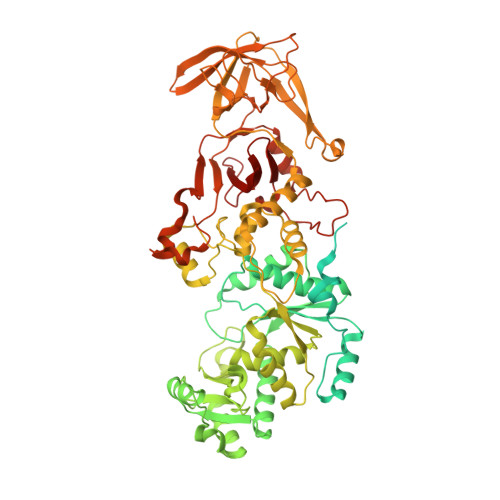Allosteric inhibition of tRNA synthetase Gln4 by N-pyrimidinyl-beta-thiophenylacrylamides exerts highly selective antifungal activity.
Puumala, E., Sychantha, D., Lach, E., Reeves, S., Nabeela, S., Fogal, M., Nigam, A., Johnson, J.W., Aspuru-Guzik, A., Shapiro, R.S., Uppuluri, P., Kalyaanamoorthy, S., Magolan, J., Whitesell, L., Robbins, N., Wright, G.D., Cowen, L.E.(2024) Cell Chem Biol
- PubMed: 38402621
- DOI: https://doi.org/10.1016/j.chembiol.2024.01.010
- Primary Citation of Related Structures:
8UK6 - PubMed Abstract:
Candida species are among the most prevalent causes of systemic fungal infections, which account for ∼1.5 million annual fatalities. Here, we build on a compound screen that identified the molecule N-pyrimidinyl-β-thiophenylacrylamide (NP-BTA), which strongly inhibits Candida albicans growth. NP-BTA was hypothesized to target C. albicans glutaminyl-tRNA synthetase, Gln4. Here, we confirmed through in vitro amino-acylation assays NP-BTA is a potent inhibitor of Gln4, and we defined how NP-BTA arrests Gln4's transferase activity using co-crystallography. This analysis also uncovered Met496 as a critical residue for the compound's species-selective target engagement and potency. Structure-activity relationship (SAR) studies demonstrated the NP-BTA scaffold is subject to oxidative and non-oxidative metabolism, making it unsuitable for systemic administration. In a mouse dermatomycosis model, however, topical application of the compound provided significant therapeutic benefit. This work expands the repertoire of antifungal protein synthesis target mechanisms and provides a path to develop Gln4 inhibitors.
Organizational Affiliation:
Department of Molecular Genetics, University of Toronto, Toronto, ON M5S 1A8, Canada.
















